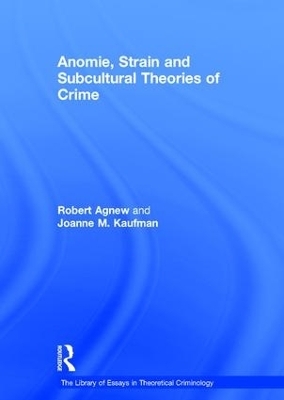
Anomie, Strain and Subcultural Theories of Crime
Routledge (Verlag)
978-0-7546-2912-2 (ISBN)
Anomie, strain and subcultural theories are among the leading theories of crime. Anomie theories state that crime results from the failure of society to regulate adequately the behavior of individuals, particularly the efforts of individuals to achieve monetary success. Strain theories focus on the impact of strains or stressors on crime, including the inability to achieve monetary success through legal channels. And subcultural theories argue that some individuals turn to crime because they belong to groups that excuse, justify or approve of crime. This volume presents the leading selections on each theory, including the original statements of the theories, key efforts to revise the theories, and the latest statements of each theory. The coeditors, Robert Agnew and Joanne Kaufman, are prominent strain theorists; and their introductory essay provides an overview of the theories, discusses the relationship between them, and introduces each of the selections.
Professor Robert Agnew, Emory University, USA and Joanne M. Kaufman, Dr, University at Albany, SUNY, New York, USA
Contents: Introduction; Part I The Origins of Strain, Anomie, and Subcultural Theory: Classic Statements; Anomic suicide, Emile Durkheim; Social structure and anomie, Robert K. Merton; Illegitimate means, anomie, and deviant behavior, Richard A. Cloward; The sociology of the deviant act: anomie theory and beyond, Albert K. Cohen. Part II The Development of Strain Theory: Control criticisms of strain theories: an assessment of theoretical and empirical adequacy, Thomas J. Bernard; Delinquency and the age structure of society, David F. Greenberg. Part III General Strain Theory: Foundation for a general strain theory of crime and delinquency, Robert Agnew; Gender and crime: a general strain theory perspective, Lisa M. Broidy and Robert Agnew; Building on the foundation of general strain theory: specifying the types of strain most likely to lead to crime and delinquency, Robert Agnew. Part IV The Development of Subcultural Theory: Delinquent subcultures: sociological interpretations of gang delinquency, David J. Bordua; Sub-cultural theory: virtues and vices, Jock Young. Part V Contemporary Subcultural Theories: Angry aggression among the 'truly disadvantaged', Thomas J. Bernard; The code of the streets, Elijah Anderson; Up it up: gender and the accomplishment of street robbery, Jody Miller. Part VI The Development of Anomie Theory: Merton's Social Structure and Anomie: the road not taken, Steven F. Messner; Global anomie, dysnomie, and economic crime: hidden consequences of neoliberalism and globalization in Russia and around the world, Nikos Passas. Part VII Institutional-Anomie Theory: Political restraint of the market and levels of criminal homicide: a cross-national application of institutional-anomie theory, Steven F. Messner and Richard Rosenfeld; Social organization and instrumental crime: assessing the empirical validity of classic and contemporary anomie theories, Eric P. Baumer and Regan Gustafson; Institutions, anomie, and violent crime: clarifying and elaborating institutional-anomie theory, Steven F. Messner, Helmut Thome and Richard Rosenfeld; Name Index.
| Erscheint lt. Verlag | 23.8.2010 |
|---|---|
| Reihe/Serie | The Library of Essays in Theoretical Criminology |
| Verlagsort | London |
| Sprache | englisch |
| Maße | 174 x 246 mm |
| Gewicht | 2740 g |
| Themenwelt | Recht / Steuern ► Allgemeines / Lexika |
| Recht / Steuern ► Arbeits- / Sozialrecht ► Sozialrecht | |
| Recht / Steuern ► EU / Internationales Recht | |
| Recht / Steuern ► Strafrecht ► Kriminologie | |
| Sozialwissenschaften | |
| ISBN-10 | 0-7546-2912-0 / 0754629120 |
| ISBN-13 | 978-0-7546-2912-2 / 9780754629122 |
| Zustand | Neuware |
| Haben Sie eine Frage zum Produkt? |
aus dem Bereich


